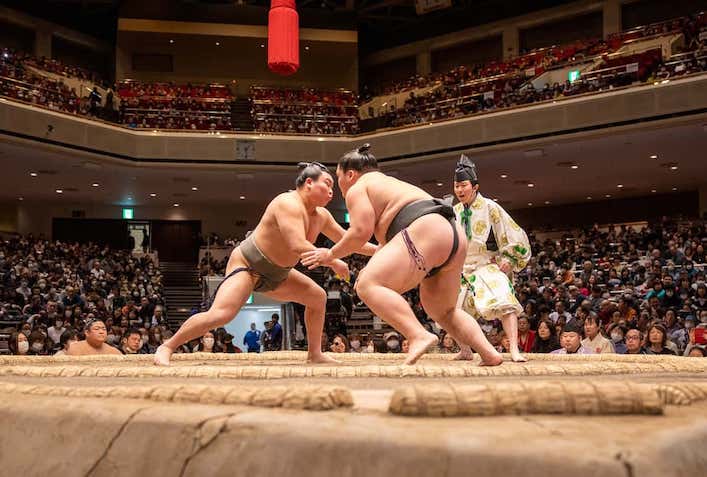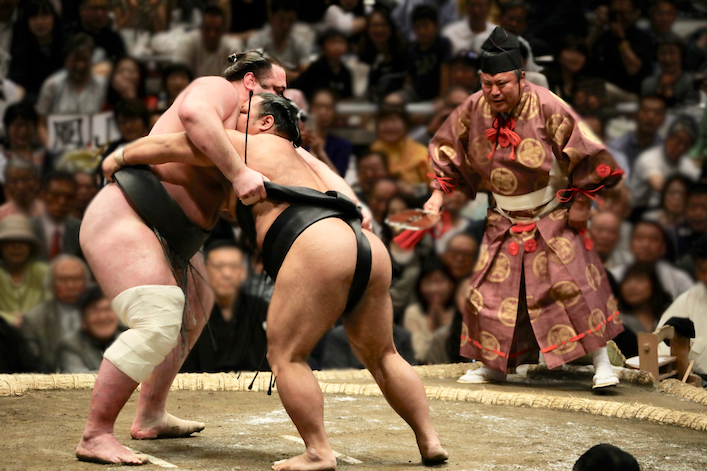
Introduction
Sumo wrestling is a traditional Japanese sport that has been around for centuries. It is a highly respected cultural phenomenon that involves two wrestlers trying to push each other out of a ring. The sumo wrestling ranking system is complex and unique, with each wrestler holding a specific position based on their win-loss record. Understanding the ranking system is important for any fan of the sport as it helps to appreciate the skill and dedication required to achieve the highest rank.
Explanation of Sumo Wrestling Ranking System
The sumo wrestling ranking system is divided into six divisions, with each division having a specific rank for each wrestler based on their win-loss record. The top division called the Makuuchi division, has 42 wrestlers, with the highest rank being Yokozuna. Rankings are determined based on the number of wins and losses accumulated over six tournaments, held three times a year.
Importance of Understanding the Ranking System
Understanding the sumo wrestling ranking system allows fans to appreciate the level of competition and dedication required to become a top-ranked wrestler. It also helps fans to follow their favorite wrestlers’ career progression as they climb the ranks. Without an understanding of the ranking system, fans may have difficulty understanding the significance of a wrestler’s position or their chances of winning an upcoming tournament.
In fact, the sumo wrestling ranking system is an essential aspect of the sport. It is a highly complex and unique system that determines each wrestler’s position based on their win-loss record. Understanding the ranking system is crucial for both fans and wrestlers alike to appreciate the level of dedication required to reach the top ranks.
History of the Sumo Wrestling Ranking System
Sumo wrestling is an ancient Japanese sport that has been around for more than 1,500 years. In this sport, two wrestlers (rikishi) battle to push each other out of the circular ring (dohyō). The ranking system in sumo wrestling is an integral part of the sport, and it determines a wrestler’s status, power, and earnings.
The ranking system in sumo wrestling has evolved over time. In ancient times, wrestling matches were organized by the emperors and were used to determine the strongest and most skilled warriors.
Overview of the Early Ranking System
In the Heian period (794-1185), organizers started hosting sumo wrestling tournaments. They rewarded top performers with rice and other food, but no formal ranking system existed.
Introduction of Modern Ranking System
It was not until the early 17th century that a formal ranking system was established. During this time, sumo wrestling became quite popular, and the Shogun (military ruler) began to appoint wrestlers to different ranks based on their skills and achievements.
The ranking system was divided into two categories: elite wrestlers (yokozuna) and non-elite wrestlers (rikishi). Only a select few wrestlers were given the title of yokozuna, and they were considered to be the strongest and most skilled fighters in the sport.
Evolution and Changes Over the Years
Over the years, there have been a number of changes to the ranking system. For example, in 1909, the current system of six ranks (makuuchi, jūryō, makushita, sandanme, jonidan, and jonokuchi) was established. These ranks are based on a wrestler’s win-loss record, and wrestlers who win more matches move up in rank, while those who lose more matches move down.
In addition to win-loss records, other factors can also influence a wrestler’s ranking. For example, injuries and suspensions can result in a lower ranking, while strong performances in tournaments can lead to a higher ranking.
Today, the highest rank in sumo wrestling is yokozuna, followed by ozeki, sekiwake, komusubi, maegashira, juryo, makushita, and lower-ranked wrestlers.
Essentially, the ranking system in sumo wrestling is a complex system that has evolved over time. It plays a critical role in determining a wrestler’s status, power, and earnings, and it is based on a wrestler’s win-loss record, among other factors. As sumo wrestling continues to evolve, it will be interesting to see how the ranking system continues to change and adapt to the modern world.
Read: How to Train Like a Sumo Wrestler: Tips & Techniques
Understanding the Modern Ranking System
Sumo wrestling is an ancient sport originating in Japan, dating back almost two thousand years. Modern Sumo wrestling, however, has undergone many changes since its inception, with the introduction of various ranking systems being just one of them. Understanding the current ranking system is important if one is to follow Sumo wrestling today.
Innovative Tech Solutions, Tailored for You
Our leading tech firm crafts custom software, web & mobile apps, designed with your unique needs in mind. Elevate your business with cutting-edge solutions no one else can offer.
Start NowOverview of Divisions and Rankings
The current Sumo ranking system categorizes wrestlers into six separate divisions based on their abilities and experience. The divisions are, in ascending order, Jonokuchi, Jonidan, Sandanme, Makushita, Juryo, and Makuuchi. Wrestlers ranked in the lower-level divisions compete more frequently and have to win more matches to progress. The top wrestlers compete in the Makuuchi division, where they are judged on their performances against each other.
Criteria for Promotion and Demotion
To move up the Sumo ranks, a wrestler must maintain a high level of performance. The minimum requirement is for a wrestler to have a winning record of eight matches out of fifteen at a tournament. A winning record means the wrestler wins more matches than he loses. The higher the division, the tougher and more experienced the competition; thus it becomes more challenging to maintain a winning record.
Conversely, if a wrestler has a losing record, they will be demoted to the lower division in which they performed well. If a wrestler performs insufficiently, they may also face the prospect of being expelled from the ranking system altogether.
Explanation of Yokozuna – the Highest Rank
The Yokozuna is the most prestigious rank in Sumo wrestling. To achieve this rank, a wrestler must win two consecutive tournaments in the Makuuchi division. The Yokozuna is considered the “Grand Champion” and is expected to be exceptional both in and out of the ring.
Once a wrestler achieves the rank of Yokozuna, they must maintain their high performance and display the attributes of the ideal Sumo wrestler, which includes respect, humility, and courage. There have only been 72 Yokozuna in the history of Sumo wrestling, and currently, there are only four active wrestlers with this rank.
To sum up, the Sumo wrestling ranking system is vital in understanding how the sport operates. Knowing the divisions and rankings within them, the criteria for demotion and promotion, and the criteria for achieving the highest rank, the Yokozuna is crucial information to enjoy the sport fully. While it may seem straightforward in theory, the ranking system is maintained meticulously, and as such, it is a source of pride and honor for those who participate in this ancient sport.
Factors that Affect Ranking System
Sumo wrestling is a traditional Japanese sport that has been around for centuries. It has a unique ranking system that is not only complex but also very interesting. The ranking system in Sumo wrestling is known as the banzuke. In this blog post, we will explore the factors that affect the banzuke ranking system in Sumo wrestling.
Performance in Tournaments
One of the key factors that affect the banzuke ranking system is the performance of a wrestler in tournaments. In Sumo wrestling, there are six major tournaments per year, commonly known as honbasho. These tournaments are held in January, March, May, July, September, and November. A wrestler’s performance in these tournaments plays a significant role in their ranking.
Win-Loss Record
Another factor that affects the banzuke ranking system is a wrestler’s win-loss record. A wrestler’s win-loss record is the number of wins and losses they have in a sumo tournament. A higher win-loss record usually results in a higher ranking on the banzuke. Conversely, a poor win-loss record can cause a wrestler to drop in the rankings.
Influence of Injuries
Injuries are common in Sumo wrestling, and they can significantly impact a wrestler’s performance and ranking. If a wrestler is injured, they may not be able to participate in tournaments or perform to their full potential. As a result, their rank may be affected. However, if a wrestler performs well despite their injuries, their rank may improve.
Ranking System in Sumo Wrestling
The banzuke ranking system in Sumo wrestling is based on a wrestler’s performance in tournaments, win-loss record, and injuries. It is a complex system that takes into account many factors, including the wrestler’s previous rank and their opponent’s rank. A higher ranking in Sumo wrestling is not only a sign of a wrestler’s skill but also a mark of their success.
Top Divisions in Sumo Wrestling
In Sumo wrestling, there are six divisions, each with a different rank. The two top divisions are the makuuchi and juryo divisions. The makuuchi division consists of the top 42 wrestlers in Sumo wrestling, while the juryo division consists of the next 28 wrestlers. These two divisions are the most prestigious in Sumo wrestling, and being promoted to the makuuchi division is a significant achievement.
Lower Divisions in Sumo Wrestling
The lower four divisions in Sumo wrestling are the makushita, sandanme, jonidan, and jonokuchi. These lower divisions consist of wrestlers who are still developing their skills and working their way up the rankings. However, even in these lower divisions, a wrestler’s performance is still crucial for their ranking.
Essentially, the banzuke ranking system in Sumo wrestling is a complex and fascinating system that takes into account many factors. A wrestler’s performance in tournaments, win-loss record, and injuries are just some of the factors that affect their ranking. The ranking system is designed to reflect a wrestler’s skill level and success in Sumo wrestling. Whether a wrestler is competing in the top divisions or the lower divisions, their ranking is a testament to their dedication and hard work.
Read: The History of Sumo Wrestling: A Deep Dive
The Importance of Ranking System in Sumo Wrestling
Sumo wrestling is a traditional Japanese sport wherein wrestlers compete against each other inside a ring. The sport has a ranking system which is essential in determining the championship matches and also plays a significant role in building and sustaining a wrestler’s career.
Determination of Championship Matches
- The Sumo ranking system determines the opponent of each wrestler for every match.
- The rankings of wrestlers are based on their performance in the past tournaments.
- The higher the rank of a wrestler, the more challenging the opponent they will face.
- The top-ranking wrestlers will compete for the title of yokozuna, the highest rank in Sumo.
Significance of Achieving Higher Ranks
- Sumo wrestlers aim to achieve higher ranks to earn more money, fame, and respect.
- The higher the rank, the more significant the financial rewards and the more lucrative endorsements from sponsors.
- Top-ranked wrestlers are also given special privileges such as the ability to wear a fancy apron and the right to enter the ring last for their matches.
- Higher-ranking wrestlers are also given more say in the sumo association’s decision-making process.
Role in Building and Sustaining a Career
- The Sumo ranking system plays a vital role in building and sustaining a wrestler’s career.
- Wrestlers need to maintain their rank or move up the rankings to remain relevant in the sport and keep their career going.
- A wrestler’s rank also determines their training partners and their daily schedule.
- Lower-ranked wrestlers are responsible for chores and tasks around the stable, including cooking and cleaning.
- Sumo wrestlers’ longevity in the sport is determined by their performance in the ranked tournaments and their ability to sustain their rankings.
All in all, the Sumo wrestling ranking system is crucial to the sport as it helps determine the championship matches and plays a significant role in a wrestler’s career. Achieving higher rankings in Sumo leads to more money, respect, and fame for the wrestlers.
Additionally, maintaining or moving up the rankings is necessary to keep a career going in the sport. The Sumo ranking system has stood the test of time and continues to be an integral part of the traditional Japanese sport.

Criticisms and Controversies of Ranking System
Sumo wrestling is a unique sport that has gained popularity around the world. Fans and enthusiasts closely follow the ranking system, which is used to determine the rankings of professional sumo wrestlers. While the ranking system has its benefits and has helped promote fair competition, it has also faced criticisms and controversies over the years.
Debate Over the Criteria for Promotion
One of the primary criticisms of the rank system in sumo wrestling is related to the criteria for promotion. The traditional criteria for rank promotion are based on the number of wins and losses that a wrestler bags during tournaments. However, the use of this system has been challenged in recent years, with many experts arguing that it is not a reliable indicator of a wrestler’s worth.
The argument is that other factors, such as training, strength, and performance against different wrestlers, should also be considered when deciding on rank promotion. These factors enable making strategic promotion decisions that better reflect a wrestler’s true ability and are well-informed.
Criticism of Yokozuna System
Another aspect of the ranking system that has faced criticism is the Yokozuna System. The Yokozuna System is the highest title that a wrestler can attain in professional sumo wrestling. The system has been criticized for being opaque and lacking transparency.
Understanding the selection process for inclusion in the Yokozuna ranks often poses a challenge for many fans and enthusiasts. Controversial admissions of wrestlers into the Yokozuna ranks have occasionally caused discontent among fans.
Instances of Mishandling of the Ranking System
There have been a few instances where the ranking system has been mishandled over the years, causing controversies and disputes. A prominent example of this is the Panama Incident, where a group of wrestlers from the country was prevented from participating in the sumo tournaments. This incident caused a lot of criticism from fans and supporters of both the wrestlers and the sport.
Seamless API Connectivity for Next-Level Integration
Unlock limitless possibilities by connecting your systems with a custom API built to perform flawlessly. Stand apart with our solutions that others simply can’t offer.
Get StartedAnother instance of the mishandling of the ranking system is the case of Harumafuji and Takanoiwa. Harumafuji, who was a Yokozuna at the time, assaulted Takanoiwa during a social gathering, leading to his retirement. The incident highlighted the need for more effective monitoring and control of wrestlers’ behavior both inside and outside the ring.
In conclusion, while the ranking system in sumo wrestling has allowed for fair competition and exciting tournaments, it has had its share of controversies and criticisms. The debate over the criteria for promotion, criticism of Yokozuna system, and instances of mishandling of the ranking system must be addressed if the sport is to retain its moral and ethical values. With better monitoring and transparency, we can ensure that the sport remains fair and enjoyable for everyone involved.
Read: What are the Basic Rules of Sumo Wrestling?
Conclusion
Understanding the Sumo Wrestling Ranking System is an essential aspect of appreciating the ancient Japanese sport. The system’s structure is based on a set of traditions and rules that have survived over hundreds of years.
Recap
The Sumo Wrestling Ranking System uses a hierarchical ranking structure that determines a wrestler’s promotions and demotions based on their performance in official tournaments. The highest rank is Yokozuna, followed by Ozeki, Sekiwake, Komusubi, Maegashira, Juryo, and Jonidan ranks.
Reflections on the Importance of Ranking System
The ranking system of Sumo wrestling plays a vital role in the sport’s competitiveness and fairness. It ensures that the best wrestlers are always recognized and given the respect they deserve based on their accomplishments. Moreover, it adds to the excitement of Sumo matches, and fans enjoy seeing the top-ranked wrestlers compete against each other.
Future Opportunities for Improvement of the System
While the current Sumo Wrestling Ranking System has remained unchanged for a long time, there is still room for improvement. For example, some critics have called upon the Sumo Association to consider establishing more ranks or to revise how the rankings are determined. Nevertheless, the current ranking structure remains a crucial aspect of the sport, and it will always be an integral part of Sumo Wrestling culture and tradition.
Before You Go…
Hey, thank you for reading this blog to the end. I hope it was helpful. Let me tell you a little bit about Nicholas Idoko Technologies. We help businesses and companies build an online presence by developing web, mobile, desktop, and blockchain applications.
We also help aspiring software developers and programmers learn the skills they need to have a successful career. Take your first step to becoming a programming boss by joining our Learn To Code academy today!
Be sure to contact us if you need more information or have any questions! We are readily available.










